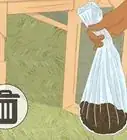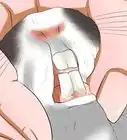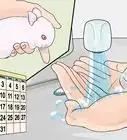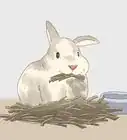This article was co-authored by Pippa Elliott, MRCVS. Dr. Elliott, BVMS, MRCVS is a veterinarian with over 30 years of experience in veterinary surgery and companion animal practice. She graduated from the University of Glasgow in 1987 with a degree in veterinary medicine and surgery. She has worked at the same animal clinic in her hometown for over 20 years.
This article has been viewed 24,652 times.
Sore hocks (also known as bumblefoot or pododermatitis) is a common condition in pet rabbits. It is so common, in fact, that owners can be more tolerant of the condition than they should be. In its mildest form, sore hocks starts with the fur on the underside of the foot wearing away. In its most severe form, the skin wears away, infection sets in, and the rabbit has a painful sore leg. If you have a pet rabbit, be on the lookout for sore hocks and be prepared to treat it before it becomes a serious ailment.
Steps
Looking For the Signs of Sore Hocks
-
1Do a regular visual inspection of your rabbit's hocks. The hocks are the rabbit equivalent of an ankle joint, and the area that's affected is the length of the paw from the hock to the tips of the toes. To check your rabbit, gently roll the rabbit onto its back so that you can see the underside of the rabbit's back legs.
- Take care not to force the rabbit over, as this can damage their spine.
- You may find it helps to cover the rabbit's eyes with a towel as this has a naturally subduing effect.
- It's a good idea to sit on the floor when checking your rabbit, just in case they wriggle and you let go.
-
2Judge the severity of the sore hocks. There is a sliding scale of severity from fur loss right through to full thickness pressure sores with secondary infections.[1] In its mildest form, the rabbit may lose the fur on the surface in contact with the ground, and the skin may look slightly red.[2]
- If the problem has progressed a bit further, the area may become puffy or swollen, the skin may be obviously reddened or even cracked or scabby.
- Even further, it can develop into a sore or ulcer form. An ulcer is when the surface of the skin breaks open, often in response to pressure, such as is the case with bed sores.[3]
Advertisement -
3Look for the signs of secondary infection. Unfortunately, once the surface of the skin is broken, this provides an entry route for bacteria and infections. To check for this, look for a weeping discharge, often consisting of pus, from the sore.[4]
- The area may smell unpleasant.
- Usually there is significant swelling and large areas of skin loss from the lower surface of the limb.
- Once the discharge is cleaned away you may even be able to see underlying structures through the gap in the skin, such as tendons or ligaments.
-
4Pay attention to behavioral signs. This rabbit will be very uncomfortable and reluctant to move around. Unfortunately this worsens the problem because the rabbit spends longer in one spot, which may be damp and contributing to the sore hocks. Thus a classic vicious circle develops.[5]
- In some cases the infection spreads into the joints or even the bones. This is very painful and the rabbit will be reluctant to move. When it does move, it will be with an abnormal gait or a limp.
- The pain and discomfort may also stop the rabbit from eating.
Getting a Veterinary Diagnosis
-
1Try to alleviate the rabbit's discomfort while waiting to take it to the vet. Keep the rabbit's claws short, so that the foot lies at a normal angle. Also give the rabbit a deep bed of soft straw, so that the injured area is cushioned a bit.
- Be sure to keep the rabbit's living space clean as well. If the hock injury was caused by the rabbit sitting in urine, clean the area and make sure it is no longer sitting in its filth.
-
2Take your rabbit to the veterinarian. If you discover your rabbit has sore hocks then seek veterinary attention. The vet will look at the hock area and assess whether the skin is damaged. If it is, the vet will also assess whether a secondary infection is present. If the answer is yes, the vet will investigate whether the infection has spread to the bones or joints, which may involve radiography of the affected bones.
- The vet will examine the rabbit to check for health problems that could cause it to sit still for longer than normal.
- The veterinarian will also check the length of the rabbit's claws. Long claws raise up the paw, especially on hard surfaces, pushing the weight back onto the rabbit's hocks.
-
3Follow your veterinarian's suggestions for treatment. The sores will need to be cleaned and wrapped, in order to prevent further irritation. Your veterinarian should show you the proper procedure for cleaning and wrapping the wound, as you will need to change the wrapping on a regular basis.[6]
- Your veterinarian my prescribe a medication, such as an antibiotic, to apply to the wound. This will help kill any infection and allow the wound to begin healing.[7]
Understanding Sore Hocks
-
1Understand how a rabbit's hocks naturally function. To understand how hock sores occur, it first helps to understand how rabbits move in the wild. They are constantly moving around from one patch of grass to another. Soil is relatively soft and allows the rabbit's claws to sink into the ground and the whole of the underside of the foot is in contact with the earth.[8] This spreads the rabbit's weight evenly over a surface that is soft and forgiving.
- Also, wild rabbits tend to be lean, so they are not carrying excess weight which presses down on the hock area.
-
2Understand why sore hocks occur. Contrast how a wild rabbit's hocks connect with the ground with pet rabbits. They move around over hard surfaces, such as carpet, laminate flooring, or lino. These surfaces do not allow the claws to dig in so the foot is naturally tilted up at the foot and down at the hock, adding pressure to the hocks.
- In addition rabbits kept in hutches for part of the time may be on abrasive surfaces such as mesh, which abrade and traumatize the skin to the lower limb.
- Also, wet bedding softens the skin and weakens its ability to form calluses and protect itself. Indeed, urine in straw macerates (softens) the skin further and dirty conditions predispose to infection.[9]
- Pet rabbits may also be overweight, which adds extra pressure onto the rear limbs.[10]
-
3Prevent sore hocks. Remove soiled areas of bedding from your rabbit's living space on a regular basis. There should be no wet areas that the rabbit can sit in and damage its skin. Also make sure that your rabbit has a good surface to stand, and sit, on. It should not have to sit or stand on a wire flooring for long periods of time.
- Trim your rabbit's nails on a regular basis, so that its long nails don't press the hocks awkwardly onto the ground.
- Also, keep your rabbit at a healthy weight, so it is not carrying excess weight. Excess weight can put extra pressure on the hocks.
Expert Q&A
-
QuestionCan rabbits die from sore hocks?
 Pippa Elliott, MRCVSDr. Elliott, BVMS, MRCVS is a veterinarian with over 30 years of experience in veterinary surgery and companion animal practice. She graduated from the University of Glasgow in 1987 with a degree in veterinary medicine and surgery. She has worked at the same animal clinic in her hometown for over 20 years.
Pippa Elliott, MRCVSDr. Elliott, BVMS, MRCVS is a veterinarian with over 30 years of experience in veterinary surgery and companion animal practice. She graduated from the University of Glasgow in 1987 with a degree in veterinary medicine and surgery. She has worked at the same animal clinic in her hometown for over 20 years.
Veterinarian Think of sore hocks like having a deep infection in your heels. If the infection is bad enough, it causes blood poisoning, which makes you feel ill and stops you from eating. In this respect, yes, it can be fatal.
Think of sore hocks like having a deep infection in your heels. If the infection is bad enough, it causes blood poisoning, which makes you feel ill and stops you from eating. In this respect, yes, it can be fatal. -
QuestionWhat are the symptoms of sore hocks in rabbits?
 Pippa Elliott, MRCVSDr. Elliott, BVMS, MRCVS is a veterinarian with over 30 years of experience in veterinary surgery and companion animal practice. She graduated from the University of Glasgow in 1987 with a degree in veterinary medicine and surgery. She has worked at the same animal clinic in her hometown for over 20 years.
Pippa Elliott, MRCVSDr. Elliott, BVMS, MRCVS is a veterinarian with over 30 years of experience in veterinary surgery and companion animal practice. She graduated from the University of Glasgow in 1987 with a degree in veterinary medicine and surgery. She has worked at the same animal clinic in her hometown for over 20 years.
Veterinarian The first sign is the underside of the rabbit's hocks (their equivalent of the ankle) looks red and sore and the fur is rubbed away. The next step is the skin breaks open and an ulcer is present. The most serious stage is if the skin then becomes infected and pus is present.
The first sign is the underside of the rabbit's hocks (their equivalent of the ankle) looks red and sore and the fur is rubbed away. The next step is the skin breaks open and an ulcer is present. The most serious stage is if the skin then becomes infected and pus is present. -
QuestionWhy do rabbits get sore hocks?
 Pippa Elliott, MRCVSDr. Elliott, BVMS, MRCVS is a veterinarian with over 30 years of experience in veterinary surgery and companion animal practice. She graduated from the University of Glasgow in 1987 with a degree in veterinary medicine and surgery. She has worked at the same animal clinic in her hometown for over 20 years.
Pippa Elliott, MRCVSDr. Elliott, BVMS, MRCVS is a veterinarian with over 30 years of experience in veterinary surgery and companion animal practice. She graduated from the University of Glasgow in 1987 with a degree in veterinary medicine and surgery. She has worked at the same animal clinic in her hometown for over 20 years.
Veterinarian Sore hocks develop when there's not enough bedding to cushion the rabbit's weight. This means their weight presses down on their hocks, which eventually become sore. If the bedding is wet, this also softens and macerates the skin making it likely to become infected.
Sore hocks develop when there's not enough bedding to cushion the rabbit's weight. This means their weight presses down on their hocks, which eventually become sore. If the bedding is wet, this also softens and macerates the skin making it likely to become infected.
References
- ↑ http://www.petmd.com/rabbit/conditions/skin/c_rb_ulcerative_pododermatitis
- ↑ http://www.petmd.com/rabbit/conditions/skin/c_rb_ulcerative_pododermatitis
- ↑ http://www.petmd.com/rabbit/conditions/skin/c_rb_ulcerative_pododermatitis
- ↑ http://www.petmd.com/rabbit/conditions/skin/c_rb_ulcerative_pododermatitis
- ↑ http://www.petmd.com/rabbit/conditions/skin/c_rb_ulcerative_pododermatitis
- ↑ http://www.bio.miami.edu/hare/sorehocks.html
- ↑ http://www.sciencedirect.com/science/article/pii/S1094919413000455
- ↑ http://ontariorabbits.org/health/sore-hocks
- ↑ http://www.bio.miami.edu/hare/sorehocks.html
About This Article
To diagnose sore hocks in rabbits, check your rabbit’s hocks for signs of the condition, such as fur loss, red or cracked skin, and sores. You can also observe whether your rabbit is reluctant to move around, which may mean it's experiencing discomfort or pain from sore hocks. If you notice any of these symptoms, bring your rabbit to the vet so they can assess the situation and suggest treatment if necessary. For more tips from our Veterinary co-author, including how to roll your rabbit over in order to inspect its hocks, read on!
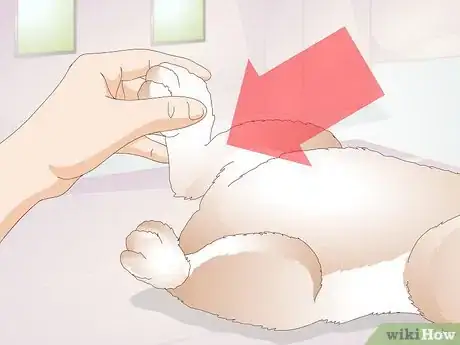
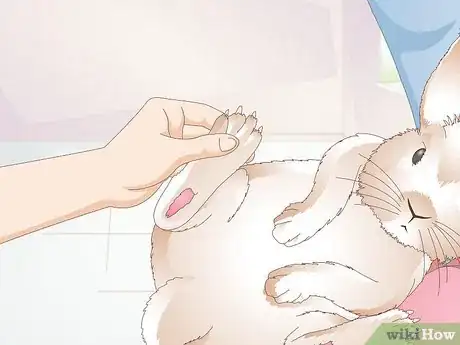

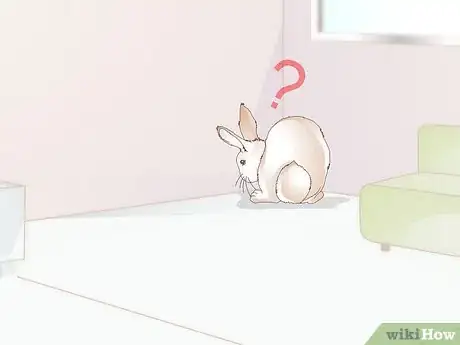
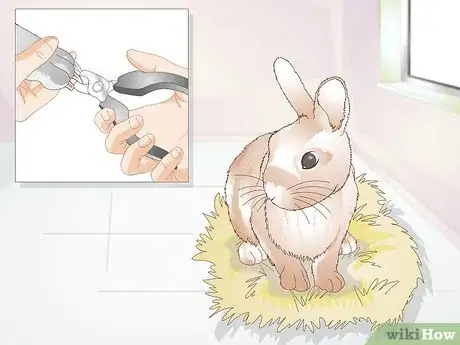
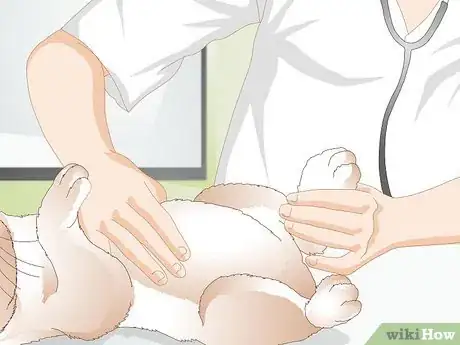


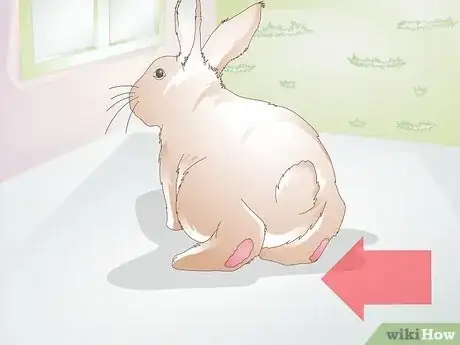
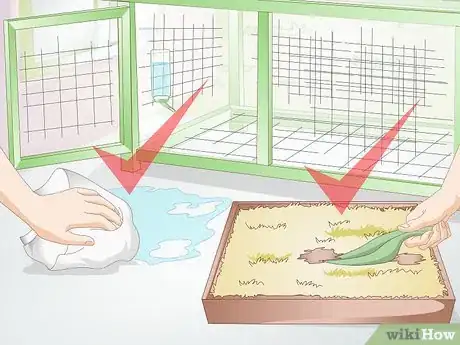
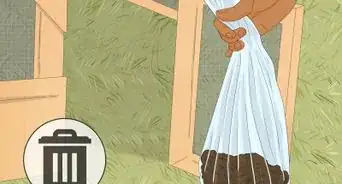
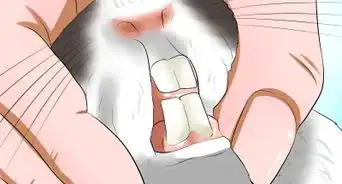
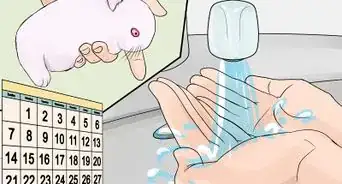
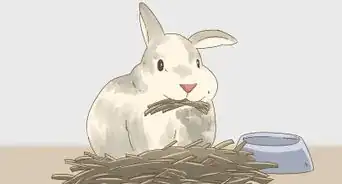
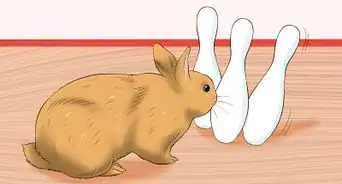
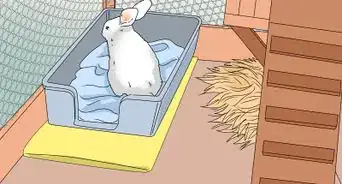
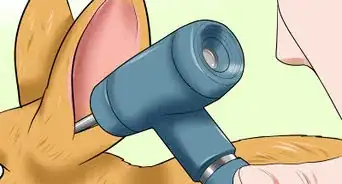
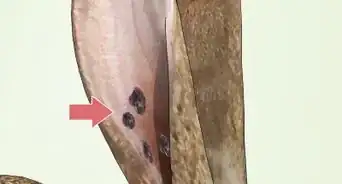
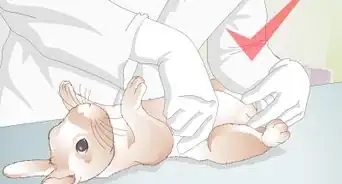
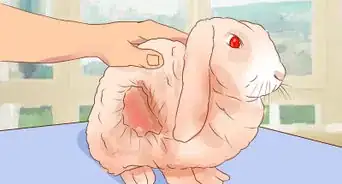
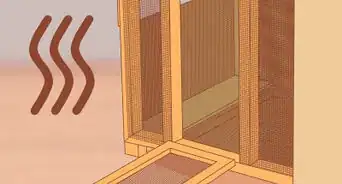

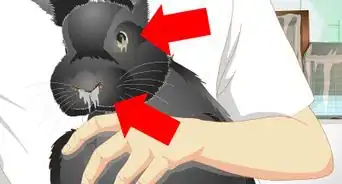
-in-Rabbits-Step-12.webp)








